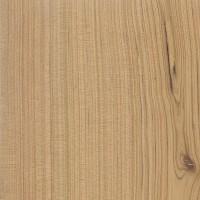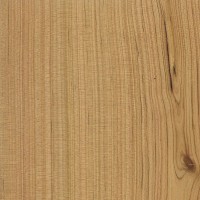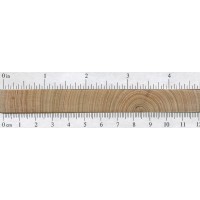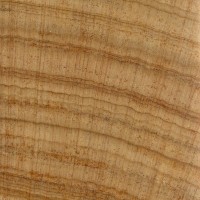 |
Common Name(s): Australian Cypress, White Cypress Pine Scientific Name: Callitris columellaris (= C. glaucophylla) Distribution: Australia Tree Size: 65-100 ft (20-30 m) tall, 1.5-2 ft (.5-.6 m) trunk diameter Average Dried Weight: 41 lbs/ft3 (650 kg/m3) Specific Gravity (Basic, 12% MC): .56, .65 Janka Hardness: 1,360 lbf (6,060 N) Modulus of Rupture: 11,550 lbf/in2 (79.6 MPa) Elastic Modulus: 1,351,000 lbf/in2 (9.32 GPa) Crushing Strength: 7,460 lbf/in2 (51.5 MPa) Shrinkage: Radial: 3.7%, Tangential: 4.9%, Volumetric: 8.7%, T/R Ratio: 1.3 |
Color/Appearance: Heartwood color can vary between boards, ranging from light tan to darker brown, commonly with darker reddish brown streaks. Pale yellow or pinkish sapwood. Commonly small, tight knots are present throughout the wood.
Grain/Texture: Grain is straight, with a medium uniform texture. Has a moderate natural luster with a slightly greasy or oily feel.
Endgrain: Resin canals absent; earlywood to latewood transition usually gradual, color contrast medium to high; tracheid diameter medium-large; zonate parenchyma abundant.
Rot Resistance: Reported to be very durable regarding decay resistance, and is also resistant to insect attack.
Workability: Generally easy to work, though frequent small knots can sometimes cause tearout or other machining difficulties. Glues and finishes well.
Odor: Has a characteristic scent that is similar to Camphor.
Allergies/Toxicity: Although severe reactions are quite uncommon, Australian Cypress has been reported to cause skin irritation, as well as less common effects such as boils, swelling of eyelids, and asthma-like symptoms. See the articles Wood Allergies and Toxicity and Wood Dust Safety for more information.
Pricing/Availability: Most commonly offered as flooring, lumber prices should be moderate for an imported species.
Sustainability: This wood species is not listed in the CITES Appendices, and is reported by the IUCN as being a species of least concern.
Common Uses: Veneer, plywood, flooring, furniture, and other light construction purposes.
Comments: Although this tree is sometimes called by the confusing name White Cypress Pine, it’s not technically a true pine (Pinus genus), though it is included within the broader Cupressaceae family, which includes several genera which encompass the more general term “cypress.”
This Australian softwood species is one of the hardest conifers in the world, rivaling some species of Yew (Taxus spp.) found in the Northern Hemisphere. Consequently, it’s forgivable that this “softwood” species is commonly used for flooring.
None available.
None available.





Question – would this be suitable for flooring in a horse float – 50mm thick – I was looking at hardwood, but only ash is available locally and this has a higher “hardness”
Cypress 6.1 v Ash 4.49
has anyone used Callitris columellaris (= C. glaucophylla) (australian cypress) to line a sauna? was wondering if it would be a good material for this use?
I’m not sure about a sauna, but in Australia cypress has traditionally been used for fence posts and palings due to its excellent weather tolerance. Cyprus posts are especially good as they resist rotting in the ground better than treated Radiata pine. I imagine this moisture resistance would make it a good choice, but I don’t know the particulars of Sauna construction and what steps are taken to protect the timber from moisture and heat.
Hope that helps!
Yes Australian used many quality wood for fence posts, like lance wood and White Cypress…but we are making quality furniture in China with them. Sure, we are also making Sauna planks with Cypress, and Macrocarpa ?Cupressus Macrocarpa?, which we took from Tas., I have to say Macrocarpa is more aromatic…but Cypress more anti ants..
Fantastic for this purpose (I’m finnish australian) one drawback I’ve found is that it is a wood that doesn’t particularly like being nailed with large gauge nails as it has a tendency to split easily but if you run a light gauge and/or pre-drill you will be fine, it can also grip screws extremely tightly (they can snap while drilling so a quality self tapping screw is needed
I would like to know if Cyprus pine is suitable to for students to use to manufacture small furniture items etc. What are the rules for use of this timber?
can Australian Cypress T&G floor boards be used external for a deck with a suitable sealer applied? North Western Victoria is the location.
Can I confirm that there is a type of timber common in America called Cypress but it is NOT this timber? I think anyone who Sells timber should also use the scientific name.
Yes, in the US, “cypress” usually refers to what’s also called bald cypress. https://www.wood-database.com/cypress/
But the thing is, both Australian and America versions of cypress are both “wrong” in the sense that neither of them are true cypress species in the Cupressus genus. https://www.wood-database.com/wood-finder/?fwp_genus=cupressus
Bald cypress, also known as swamp cypress
There are no real “oak” Quercus in AA]ustralia except cultivated garden situation.There are a number of species referred to as oak, first is “Australian Oak”, or “Tasmanian Oak”, Eucalyptus obliqua, which is a type of Eucalyptus. The second is “She-oak”, a name applied to any of several species of tree in the genera Casuarina or Allocasaurina. Grevillea robusta, is commonly known as the southern silky oak, silk oak or silky oak, silver oak or Australian silver oak, is a flowering plant in the family Proteaceae. It is a tree, the largest species in its genus but is not closely related… Read more »
Tas Oak refers to E.Regnans or Mountain Ash. E.oblique refers to Messmate.
this comes from 25 years of harvesting these trees.
Messmate (E. obliqua) is also commonly included in the catch-all name for three species sold as ‘Tassie Oak’ along with E. delegatensis & E. regnans. Common names used for of timber thrown together to be sold as Tasmanian Oak include: Mountain ash, alpine ash, gum-topped stringybark, Australian oak, whitetop stringybark, white-top, woollybutt, blue leaf, mountain white gum. Tasmanian oak is marketed under different names depending on where it is being sold. In Victoria and NSW; it is also sometimes mistakenly referred to as Victorian ash. It should be noted however that, unlike Victorian ash, Tasmania oak also includes messmate. Consequently, Tasmanian oak… Read more »
I have a property with a lot of cypress pine on it and I was thinking of using it as fence posts croncreted in the ground would they last for very long or do they need to be treated.
I believe it’s rated for 25 years in-ground and about 40- 50 above. It would probably be just fine untreated, but of course, will lose colour.
It’s very good for almost ANYTHING, ships to houses.
Fence posts should last for 100 years.
Very underrated timber, can be brittle, not much good for propellers.
I have cattle yards made of it, been used before l was born, I’m 70.
This wood is a member of the pine family. The grain is nothing like oak. The color is nothing like oak. It’s a very oily yet SOFT wood. Typically used for flooring in cabins and inexpensive furniture. It’s not dense at all and after several years of drying out is extremely light.
Hi I was eyeing this table, I wonder if it’s oak. Would anyone be able to help? Thanks in advance.
picture as attached.
Highly unlikely that it’s oak. Where are you located? I noticed you posted this on the page for Australian Cypress, so definitions of “oak” may vary depending on where you’re from.
Thanks for reply. I’m located in Australia. What do you think it might be then?
Sorry, I really do not know a whole lot about native Australian species except for the handful that are exported to the United States. It may very well be a type of Australian oak. Perhaps someone with more knowledge in Aussie woods can chime in…